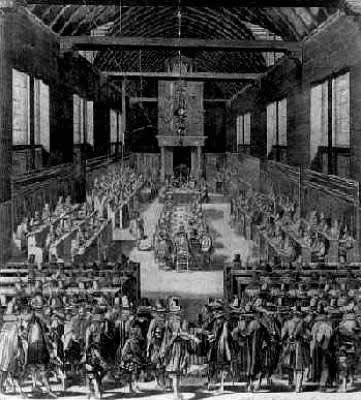6. Confessions from West and North Europe
From the middle of the 16th Century the Reformed communities in the French-speaking South of the Netherlands, which had up to this point existed individually, developed their own church underground. They called themselves the “Church under the Cross” on the model of the Huguenots. In the year 1561 Guy de Bres composed for this persecuted church the Confessio Belgica (Dutch Confession), which goes back in part to the Confessio Gallicana. This “Confession du Foy,” as it was called in the French original, was only a year later translated into Dutch. The Confessio Belgica, which was originally aimed at the Emperor Philipp II and avoided any apologetics, became very early on the determining confession in the French-speaking Walloon communities and after a few years in the Dutch communities as well – first at the Wesel Convention in 1568, then at the Emden Synod in 1571 where it was introduced as confession, and lastly at the Dordrecht Synod in 1618/19 where it was once more endorsed.
The Dordrecht Canons of 1619 can be counted next to the Heidelberg Catechism and the Dutch Confession among the important confessional texts of the Dutch Reformed churches, already reaching into the time of orthodoxy. Their emergence had its basis in the dispute between the Remonstrants (named Arminians after their spokesman Arminius) and the Counter-Remonstrants (named Gomarians after their spokesman Gomarus). The initial question was whether God elects the human on the basis of his/her foreseen faith (so the Remonstrants) or whether faith is only granted to those elected (so the Counter-Remonstrants). Understood differently is thus the relation between divine action (election) and human activity (faith), which are thought compete with one another. In the Dordrecht Canons the Dordrecht Synod clearly rejects the Arminian position and emphasises that God gives faith only to those who have previously been elected.

Dordrecht Synod
In the year of the establishment of the Reformation in Scotland, 1560, a confession was commissioned by the Scottish national parliament, was drawn up in four days by a group under the leadership of John Knox, and was then approved by parliament (but not by Queen Mary Stuart). In 25 articles this Scottish Confession (Confessio Scotica) conveys the Reformed doctrine and thereby forms the beginning of the Scottish Reformed Church (Church of Scotland). It contains Calvinist theology and differentiates itself, often explicitly, from the Roman Church and its theology.
From the Scottish Confession As we do not rashly damn that which godly men, assembled together
in general councils, lawfully gathered, have proposed unto us;
so without just examination dare we not receive whatsoever is
obtruded unto men under the name of general councils. For plain
it is, as they were men, so have some of them manifestly erred,
and that in matters of great weight and importance. So far then
as the council proves the determination and commandment that
it gives by the plain word of God, so far do we reverence and
embrace the same. But if men, under the name of a council, pretend
to forge unto us new articles of our faith, or to make constitutions
repugning to the word of God, then utterly we must refuse the
same as the doctrine of devils, which draws our souls from the
voice of our only God to follow the doctrines and constitutions
of men. *** Questions 1. In the Scottish Confession the councils stand for the authority
of the Church. What authority does the Church have? 2. What tasks, then, do councils have? 3. What role is intended for church ceremonies?
|
In the 17th Century the Confessio Scotica was replaced by the Westminster Confession. The Westminster Confession of 1647 arose in the conflict between Anglicanism and Presbyterianism in England. In 1643 a solemn alliance was formed between the Scottish and English nations. The Westminster synod, which originally had the task of the Reform of Anglicanism, was used by the (mainly Scottish) Presbyterians, who had the majority, to pass a Presbyterian confession, the Westminster Confession. The following resistance of the Anglicans made the division between the Anglicans and Presbyterians final. The Westminster Confession is characterised by a covenant theology oriented towards salvation history and so breathes a not particularly strict form of Reformed orthodoxy. The (puritan) reflection on the sanctification of individuals is decisive at many points. The Westminster Confession became next to the Heidelberg Catechism the characteristic confession of the Reformed Church world-wide. In many Anglo-Saxon Reformed churches today it functions as the principle confession.